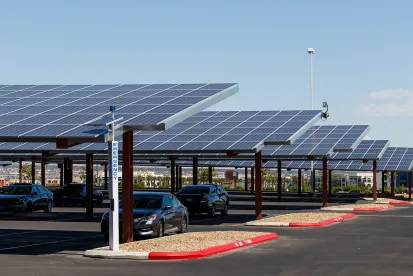The U.S. photovoltaic (PV) industry, solar module suppliers, manufacturers, and renewable energy developers are facing new regulatory challenges with the implementation of new legislation which has a significant impact on such imports. Among the most significant is the Uyghur Forced Labor Prevention Act, Pub. L. No. 117-78, 135 Stat. 1525 (2021) (“UFLPA”), whose provisions became fully effective on June 21, 2022.
As indicated in a previous blog update (see here), the UFLPA creates a rebuttable presumption that U.S. imports of goods, wares, articles, and merchandise in whole or in part produced, mined, or manufactured in the Xinjiang Uyghur Autonomous Region (XUAR) are the product of forced labor, violating 19 U.S.C. § 1307. Further, all Withhold Release Orders (WRO) that have a connection with XUAR are subsumed by UFLPA and subject to the same standards.
U.S. Customs and Border Protection (CBP) already invoked 19 U.S.C. § 1307 multiple times in the solar sector by imposing WRO’s to target entities/manufacturers or locations, imposing civil penalties, or ordering the seizure of goods. CBP will now also apply the rebuttable presumption unless it is overcome by the importer.
Identifying and removing forced labor from supply chains is not new for solar module consumers and their suppliers. The UFLPA, however, adds materially to the due diligence requirements on U.S. importers and manufacturers in the solar industry given that four of the five largest suppliers of solar panels are headquartered in China, and the fifth is also heavily invested there. The vertical supply chain is mostly controlled by Chinese producers from the polysilicon ingot right up to the module.
With the UFLPA presumption now in force, industry is watching to see what CBP actually does at the border. CBP published its own U.S. Customs and Border Protection Operational Guidance For Importers (”CBP Guidance”) on June 13, 2022 and has conducted three webinars to give guidance to importers. CBP’s Guidance is complementary to the guidance that the UFLPA required the Forced Labor Enforcement Task Force (FLETF) to publish. The FLETF published its Strategy to Prevent the Importation of Goods Mined, Produced, or Manufactured with Forced Labor in the People’s Republic of China (“Strategy”) in a report to Congress published on June 17. The Strategy also contains a list of companies working in Xinjiang that are known to use forced labor. No down-stream solar companies are listed, but a few polysilicon firms are, including Hoshine, Daqo, GCL and East Hope.
CBP has made it clear in its public statements about the UFLPA that there is no de minimis rule, and “wholly or in part” will be applied literally. The expansive scope is also clear from what the FLETF Strategy demands of importers:
To conduct a forced labor risk assessment, importers must map supply chains for their imported goods and then identify steps at risk of using forced labor.
In making a forced labor risk assessment, factors to consider include, but are not limited to:
-
Origin of imported goods and any raw materials or components in the imported good;
-
Transactions among entities along the supply chain tied to the specific imported goods;
-
Locations and identities of entities in the supply chain;
-
Business relationships among entities in the supply chain;
-
Use of publicly available datasets to estimate probability that raw materials or components originated in Xinjiang (when there are indications that raw materials or components do not originate from the stated location, such as inputs from countries that are known to lack production capacity that matches its output volume, additional due diligence is needed); and
-
Indications that a supplier at any tier of the supply chain is using detainee or ex-detainee labor or is receiving workers from Xinjiang through PRC government-labor programs.
Strategy, at 42-43 (emphasis added).
The rigor with which the UFLPA forces companies to search at remote levels up the supply chain bears more resemblance to the effort years ago to trace conflict minerals up the supply chain in the electronics sector, which resulted in the Conflict Mineral-Free Sourcing Initiative’s white list of smelters and refiners that industry could use to comply with their due diligence and reporting obligations. Some service companies with global databases of suppliers and supply chains have already begun offering risk assessment reports for U.S. importers under the UFLPA which they say will make use of vast datasets and artificial intelligence to reduce UFLPA risks.
Under the UFLPA, one of the goods targeted as a priority for enforcement is polysilicon. It was even named explicitly in section 2(d)(2)(B)(viii) of the UFLPA text. Polysilicon, a high-purity form of silicon, is a key raw material in the solar photovoltaic supply chain.
It has been estimated that almost 50% of the world’s polysilicon comes from the Xinjiang region. The Strategy asserts that companies in China which produce silica-based products are offered government subsidies to use the labor of ethnic minority groups. It refers to “credible reports” which detail the work conditions in these companies and indicate that coercive recruitment, intimidation and threats, retribution for religious beliefs, exclusion from community and social life; and threatened workers’ family members are commonly used in this sector. U.S. importers of silica-based products must be very diligent as to where the raw materials as well as the whole supply chain come from. The FLETF also highlights that these risks can come from third countries or provinces in the manufacturing processes and transshipments. It follows that Companies sourcing photovoltaic products from China need to be especially vigilant. But it is not just China. CBP has made it clear that it will also target goods from other countries if it believes they have content from Xinjiang or companies on the UFLPA Entity List, or otherwise involve forced labor. Further, U.S. companies that do not import are also required to be diligent when they purchase goods from abroad.
If CBP has information suggesting that goods have content from Xinjiang, or from companies on the UFLPA Entity List, or otherwise involve forced labor, CBP will do one of three things at import: Detention, Exclusion or Seizure. CBP has also said that it may require redelivery of goods already cleared for entry within the preceding 30 days if it obtains such information after entry.
Unless and until CBP actually seizes the goods, the importer is free to re-export them to another country.
After a detention, if the importer produces evidence substantiating that “the imported goods and their inputs are sourced completely from outside Xinjiang and have no connection to entities on the UFLPA Entity List,” CBP will allow the goods to enter assuming they are otherwise in compliance with U.S. law. CBP Guidance at 17.
In a case where the importer does not refute the Xinjiang or UFLPA Entity List connection but establishes by “clear and convincing” evidence that forced labor was not used, then CBP will grant an exception and allow the goods to enter. “Clear and convincing evidence” is, needless to say, a heavy burden to meet, and much will depend upon how reasonably and fairly CBP applies the test. When CBP finds an importer’s evidence satisfactory and allows goods to enter, it will “make available to the public a report identifying the good and the evidence considered in granting the exception.” CBP Guidance at 10.
The CBP Guidance indicates that companies should obtain an “independent verification” of the implementation and effectiveness of their due diligence system and should report their performance with respect to due diligence to the public. Id. at 14. This implies a need to have counsel or consultants independently review a company’s due diligence. Industry trade groups like the Solar Energy Industries Association (SEIA) have been working to establish supply chain traceability protocols to assist solar developers and manufacturers in their efforts to use cruelty-free products. One is reminded again of the experience with independent reviews in the conflict minerals setting.
By interpreting the UFLPA to require tracing all the way up the supply chain, the Strategy and CBP Guidance come into conflict with China’s Anti-Foreign Sanctions Law, whose Article 12(1) provides that “Any organisation and individual shall not implement or assist in the implementation of discriminatory restrictive measures taken by any foreign country against any Chinese citizen or organisation.” (see our previous article here). We expect the difficulty of gathering evidence up supply chains in China under the UFLPA to be compounded greatly by this blocking statute.
In the case of conflict minerals, industry was able to develop very useful tools to aid in verifying that supply chains were compliant. One hopes that in time similar tools may become available in solar photovoltaic and other priority sectors under the UFLPA.
Claire Le Tollec is a Leal Consultant in the firm’s Brussels office and contributed to this article.






 />i
/>i
